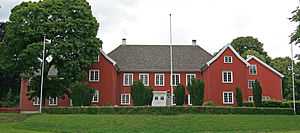Ulrik Frederik Gyldenløve
| Ulrik Frederik Gyldenløve | |
|---|---|
.JPG) | |
| Born |
20 July 1638 Bremen, Germany |
| Died |
17 April 1704 (aged 65) Hamburg, Germany |
Resting place | Church of Our Lady, Copenhagen |
| Nationality | German-Danish |
| Known for |
Gyldenløve War Gyldenløbe's Mansion Reforms |
| Spouse(s) |
Sophie Urne Marie Grubbe Countess Antoinette Augusta of Aldenburg |
| Parents |
Frederick III of Denmark and Norway Margarethe Pape |
| Awards | Order of the Elephant |
Ulrik Frederik Gyldenløve, Count of Laurvig (20 July 1638 – 1704) was the leading general in Norway during the Scanian War, whose Norwegian leg is conventionally named the "Gyldenløve War" after him. He was an acknowledged illegitimate son of King Frederick III of Denmark and Norway.[1]
Early life
Gyldenløve was born in Bremen, Germany, the illegitimate son of Prince Frederick, later King Frederick III of Denmark, who was at the time Prince-Archbishopric of Bremen and coadjutor of the Bishopric of Halberstadt. His mother was Margrethe Pape who was made Baronesse of Løvendal by King Christian IV in 15 September that same year.
When his father became King of Denmark in 1648, Ulrik Frederik assumed the name Gyldenløve which was used by illegitimate sons of Danish kings.
During the first half of the 1650s, he traveled in Europe, visiting both France, Italy and Spain. On 21 August 1655 he became a naturalised Danish noble.[2]
Military career
Civil career and holdings in Norway

In 1664 Gyldenløve was appointed Statholder (viceroy) to Norway. He studied conditions in Norway very carefully, and became a strong advocate for many important reforms, such as a simplified tax system and the establishment of a Court of appeals in Norway separate from the one in Denmark. He is also remembered for his role in the construction and improvement of nine fortresses along the Swedish border.
Gyldenløve took part in the 17th-century Dano-Swedish wars where he was particularly successful at the Battle of Nyborg on 14 November 1659. In 1666, he became commander-in-chief of the Norwegian army which was victorious in the Scanian Wars (1675–1679).
In 1671, Gyldenløve founded the city of Laurvig (modern-day Larvik), and was named Count of Laurvig. In Larvik, he is remembered for the construction of its main church as well as Herregården (Manor House), which is still one of the largest wooden structures in Norway.[3]
Gyldenløve implemented Hannibal Sehested's reforms on taxation, defence and justice and protected the tenant farmers. He was also active in Danish politics from 1670 in association with Peder Griffenfeld.
Career and holdings in Denmark
The construction of Gyldenløves Palace in Copenhagen, later to be known as Charlottenborg Palace, began on 3 April 1672 when Frederick III laid the first stone for his illegitimate son.
Family
Count Ulrik Frederik married thrice: once, childlessly, to the famous Marie Grubbe, from whom he was divorced after nine years in 1670. He wed firstly, Sophie Urne (1629-1714), daughter of Jørgen Urne and Margrete Marsvin. His third wife was Countess Antoinette Augusta von Aldenburg (1660-1701), eldest daughter of Anton I, Count von Aldenburg und Knyphausen (by his first wife, Countess Auguste Johanna zu Sayn-Wittgenstein-Hohenstein), legitimated son of Anton Gunther, last of the independent Counts of Oldenburg, who belonged to the Delmenhorst cadet branch of the House of Oldenburg whose senior line became hereditary kings of Denmark. Ulrik Frederik's two first marriages ended in divorces, but he has descendants from the first and third.
According to contemporary accounts, he also had an amorous relationship with Count Peder Griffenfeld, who went on to become a leading statesman in Denmark-Norway.
He had four children, all of whom lived to adulthood, married and left descendants: By Sophie Urne:
- Woldemar Gyldenløve
By Countess Antoinette Augusta von Aldenburg:
- Countess Charlotte Amalie af Danneskiold-Samsøe (1682-1699), wed Christian Gyldenløve (1674-1703)
- Ulrikke Amalie Antoinette af Danneskiold-Samsøe (1686-1755), wed Count Carl von Ahlefeldt (1670-1722)
- Ferdinand Anton, Count af Danneskiold-Samsøe (1688-1754), wed Countess Ulrikke Eleonore af Reventlow (1690-1754)
Through his daughter, Charlotte Amalie, and her daughter, Countess Frederikke Louise af Danneskiold-Samsø (by her marriage to Christian Gyldenløve, an illegitimate son of Christian V of Denmark), Ulrik Frederik became the ancestor of the Dukes of Augustenborg and thus, among others, of Frederick VIII, Duke of Schleswig-Holstein and the German Empress Augusta.
See also
References
- ↑ Biography of Ulrik Fredrik Gyldenløve (Dansk biografisk Lexikon 1887-1905)
- ↑ "Ulrik Frederik Gyldenløve" (in Danish). Stamtavler over danske adelsslægter. Retrieved 2011-10-16.
- ↑ Herregården (Norway Attraction0
Other sources
- A History of Norway by Karen Larson, Princeton University Press, 1948
- The History of the Norwegian People by Knut Gjerset, MacMillan, 1915
- Ulrik Frederik Gyldenløve by O. v. Munthe af Morgenstierne, Munskgaard, 1944 (in Danish).
External links
| |||||||
